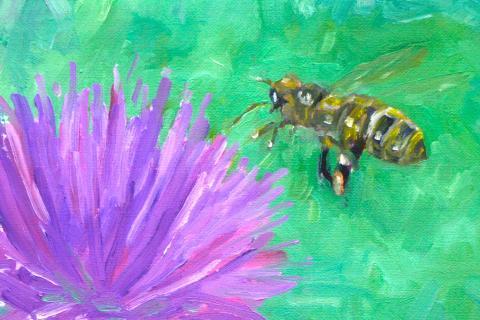
Pranayama is an umbrella term for different breathing exercises. Some of these exercises have different goals than others, but the gist is the same: to regulate or control your breath, sink into the experience, and alter your energy through the breath.
Bhramari pranayama is one of my favorite pranayama techniques to practice because it is so simple and comes with so many sweet benefits. Unlike some other pranayama techniques (like nadi shodhana/anulom-vilom, or alternate nostril breathing, which should not be practiced with a sinus infection or other congestive cold; or kapalabhati, which should not be practiced by pregnant women), anyone can practice bhramari pranayama. And, it’s more than likely that you already incorporate a little bit of bhramari-like breath into your life already.
Have you ever made a “mmm” sound after a bite of something delicious? Or while in a really warm hug? Or maybe when you’re falling asleep or waking up? That satisfied “mmm” sound we make sometimes provides benefits similar to those of bhramari pranayama. It is our way of subconsciously increasing the vibrations in the body by stimulating the nerves throughout.
Practicing the bhramari pranayama, which can really be done anywhere and at anytime (while being respectful), increases the flow of energy in the body while calming the mind. While practicing this pranayama, we create vibrations within our vocal chords that resonate throughout the throat, chest, and head (and beyond!), where large groupings of our “nadi” (nerves) are located. As a result, these body-wide vibrations activate nerve endings, and in a sense “shake out” negative energies, cleansing our body.
The practice of bhramari pranayama is beneficial for anyone, but especially for those experiencing stress, tension, anxiety, insomnia, migraines, and thyroid problems. Bhramari pranayama is ideal for preparing for meditation, as the gentle humming breath calms the mind and cleanses the nerves.
How to perform Bhramari pranayama:
Find yourself in a comfortable seated position with a straight spine and sit bones grounded. Close your eyes and mouth throughout the entire practice. This is helpful in blocking out the distraction of other senses and turning awareness inward, toward the third eye center, the space between the eyebrows. Breath should always flow in and out through the nose, and there should be no tension in the face or jaw. Choose one of the following mudra variations:
Variation 1: Place index fingers in the ear hole or gently press the tragus over the ear hole to block out surrounding sound.
Variation 2: Press your thumb on the tragus, gently resting the pointer and middle fingers of each hand over the eyelids and the ring and pinky fingers on the cheeks.
*Experiment with the pitch of the hum in this variation; the contact between the hands and the eyes and ears allows one to feel how sensations in the chest/throat/head/senses change with a change in pitch.
Variation 3: Cup the palms of the hands over the ears to block out surrounding sound.
Inhale deeply from the stomach, up through the ribcage, chest and to the collarbone. As you exhale – always keeping your mouth closed, jaw loose and teeth slightly separated – generate a long, gentle humming sound from the back of the throat and nose.
The hum can be any pitch, but the pitch affects where and how the humming/vibration sensation is felt. A lower, deeper hum is felt more in the throat and chest, between the heart (anahata) and throat (vishuddi) chakras. A higher, singing hum is felt more in the upper senses and top of the head, near the third eye chakra (ajna). Experimenting with the tone of your sweethoneybee hum can reveal new feelings in using your voice during yoga asana practice.
Practice this cycle of inhale and exhale with hum between 3-12 times, and up to 4 times per day. It is best to practice bhramari pranayama 2-3 hours after eating.








